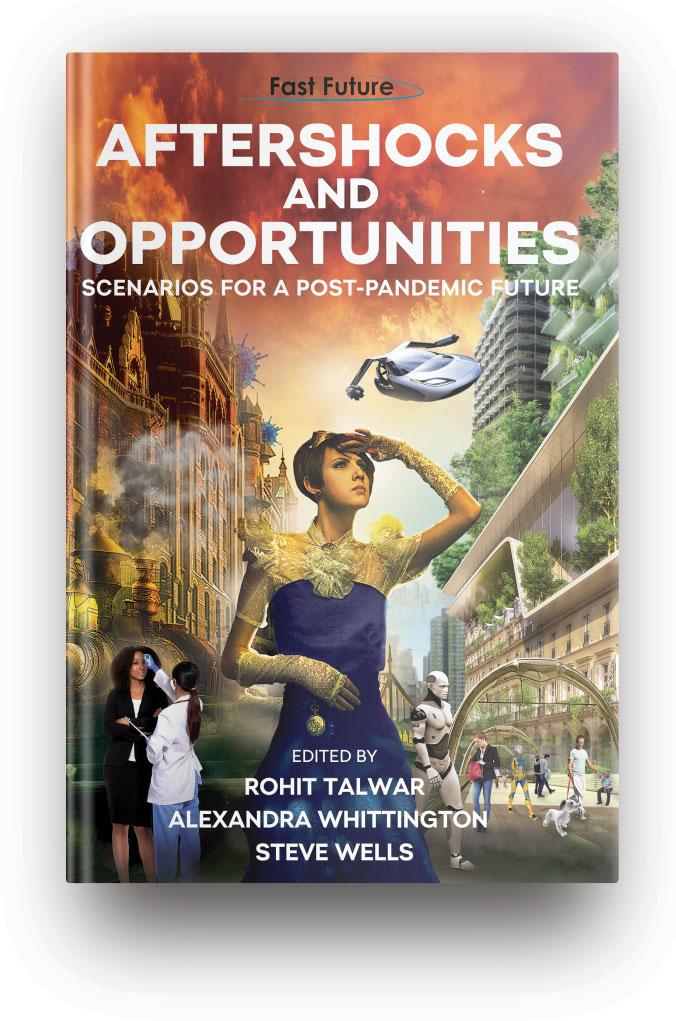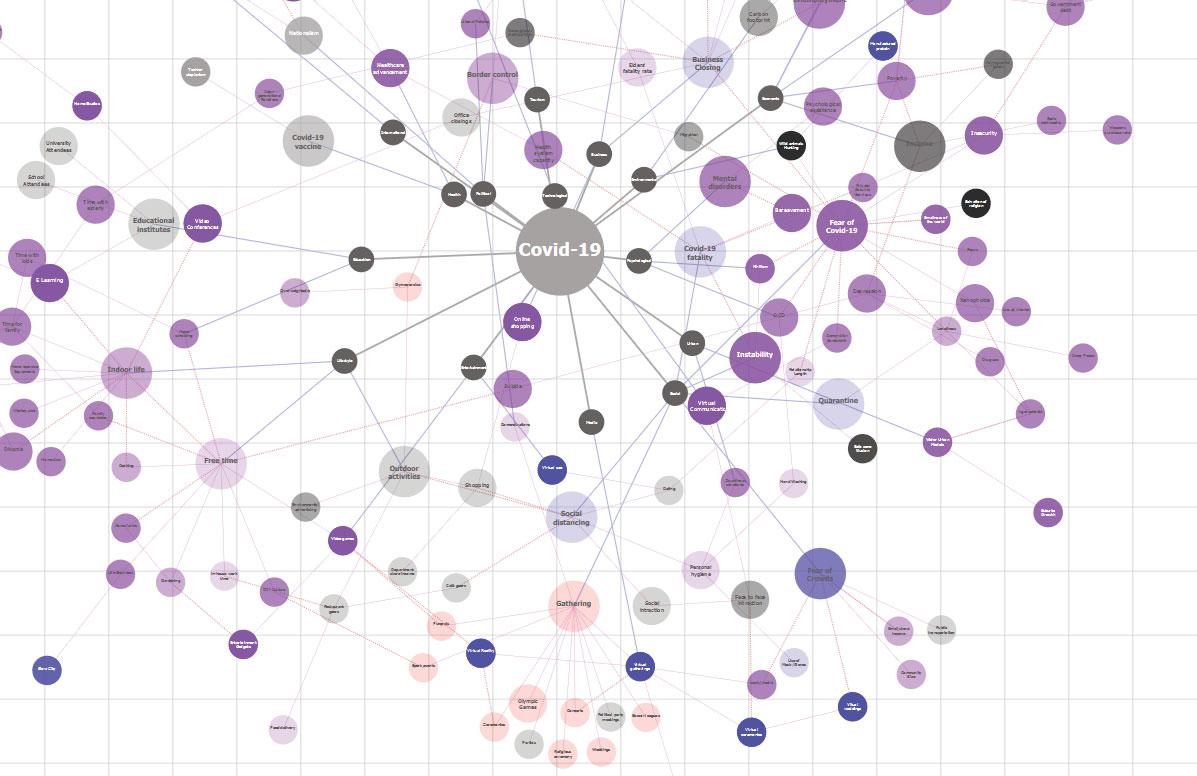
6 minute read
SMART FUTURES?
Claire Nelson SMART FUTURES?
I have been doing a lot of thinking about the use of Futures Thinking to solve problems in the last six months. The topic of THE Future (as if there were only one version of it) has become the ‘it’ topic since the beginning of ‘The Great Pause’ or ‘The Global Tsunami’ or whatever name you want to give it. There are so many challenges to be addressed by leaders everywhere and all levels that the demand for problem solvers and problem solving skill is at an all time high. What to do about the restart of school? Or mask policy? or testing policy? or test labs or business reopening?
In my search for ways we can help design the Reset Button, I have come across numerous offerings for seminars and webinars – from Future of Health to Future of Cybersecurity all purporting to help zoom us across the great divide between (1) the past future we must bury, and (2) the new future we must birth.
This started me down a rabbit hole trying to identify how best to solve the challenge of problem solving through improving ‘telos thinking’ around the crucial fi rst step of problem defi nition and articulation of complex systems and systems of systems. Thusly, I soon found myself in a worm hole – ‘a la Star Trek’ that took me into a space-time warp of tools. Picture it a galaxy of stars - each star representing a challenge or an opportunity and therein is a wormhole connecting problem defi nition to problem solution and in that space time tunnel is a pantheon of tools fl oating like antimatter. There are so many tools for problem solving, it is mindboggling that we have not yet reached a solid state of teleological effectiveness. Maybe it is in our defi nition of the task itself. Let’s see problem solving is the process of a problem analysis and resolving it in the best way possible for that situation. So, now what is analysis. This is a process of analyzing a problem - no.. we cannot use the same word in clause of the defi nition of the verb. So, let us rework this to say problem analysis is a process of defi ning the root causes of the problem in order to defi ne (root cause analysis) countermeasures that correct or redress for the problem and then to implementing the best solution or combination thereof for the given problem situation. Problem analysis begins with problem defi nition. This sounds simple enough - in theory. Indeed, all seems well and good when we are talking about deciding how to fi x a fl at tire or a leaky faucet or the slow computer. These are problems that have a seemingly fi nite number of plausive, possible, and preferred alternative outcomes and solutions. One can review the tools at our disposal and using our critical thinking and analytical skills we can identify pros and cons of tool A versus Tool B and arrive at a teleological solution or in layman’s terms the solution which provides the best positive outcome bearing in mind the potential negative consequences. But I found myself in a trap or rather a hole --not to mix metaphors. Even the simple cases I propose demand a decision around space and time limits. How do we limit the solution and problem space for time and distance? There have been many problem-solving techniques
developed and used across disciplines as diverse as computer science to chemical engineering to medical diagnosis to psychology testing. But how do we know which to use when and where? What are the most known and used models and methods? What are their success stories and practical tips when you apply these?
There is the PDCA cycle which stands for the abbreviation of the four main steps in the cycle: Plan, Do, Check and (Re) Act. Another framework Lateral Thinking by Edward de Bono encourages us to change the way we look at a problem which helps with being creative and to solve problems. There is interrelationship diagram which is a graphical tool that is used to demonstrate various relationships between factors, processes, areas, or other aspects. We fi nd also the Systematic Inventive Thinking (SIT) methodology where creativity takes center stage, which contains fi ve thinking patterns that humans have used for thousands of years. There are many many many tools and approaches with names like Soft Systems Methodology (SSM) and Cause and Effect Analyses, which are supposed to help enable problem solvers to broaden their minds, and to look at the bigger picture with regards to the problem. But what is often missing from all these tools is the fact that we may need to shift our lens, our worldview altogether in order to best use and/or benefi t from any tool.
The journey to a post Covid New Normal of thriving will demand that from all of us. Futures thinking must begin with holism as a way of seeing the world. We must recognize that our tendency to reduce our problematic systems to parts in order to address them does not mean that we are in fact working with a collection or addition of parts. The whole is indeed more than and operates differently from the sum of the parts. We need all to begin to internalize the construct of holism as a way of viewing all reality past, present and future. The holistic view of the SDGs means that we must see them as ONE track to increased global sustainability with 17 delineated individual lanes we must traverse and with each individual lane having its own important role, but also being fully a part of the integrated system. We might do well to use the metaphor of the fi eld of holistic medicine, which focuses on treating all aspects of a person's health including physical symptoms, psychological factors, and societal infl uences. We could use holism as a way to achieve human or planetary scale human health.
The holistic futures problem solving approach proposes that it is necessary to look at the entire health system of a country rather than focus on just one aspect of the health care problematic, and to recognize that various factors interact and infl uence each other.
This is important because the reality is that the future is ever emerging and evolving, much like a star map, as each actor in the systems under study acts to address and infl uence the future. A critical issue that will need to be addressed is how to get an increasingly individualistic culture to get more comfortable with our interdependence as a way of being. How to bring more collectivist cultures to the narrative of thriving futures we want? How do we emphasize the needs and goals of the group as-a-whole over the needs and desires of each individual so that we can get to just and equitable futures? Thinking about this Great Pause and the problematics we fi nd our self in, it seems as if the COVID-19 Pandemic is just the wild card we needed, but did
not want, to create defl ection points that will drive starship Earth towards a safer future.









